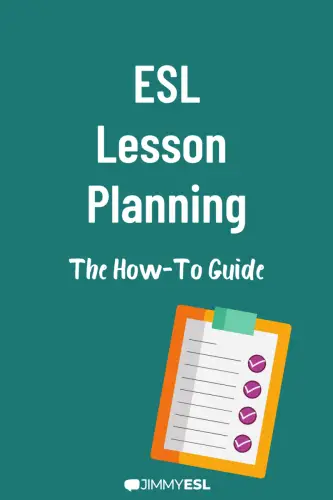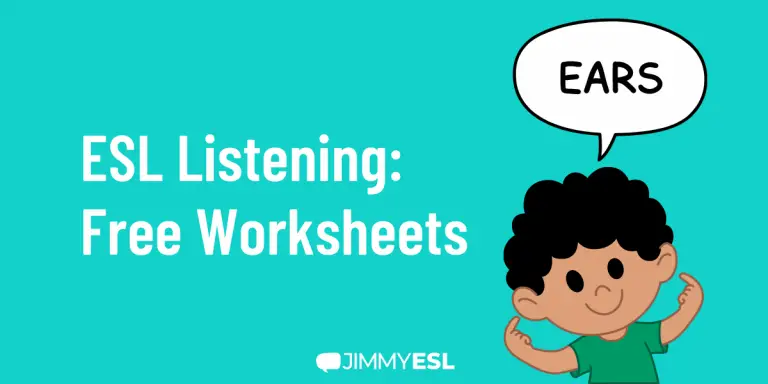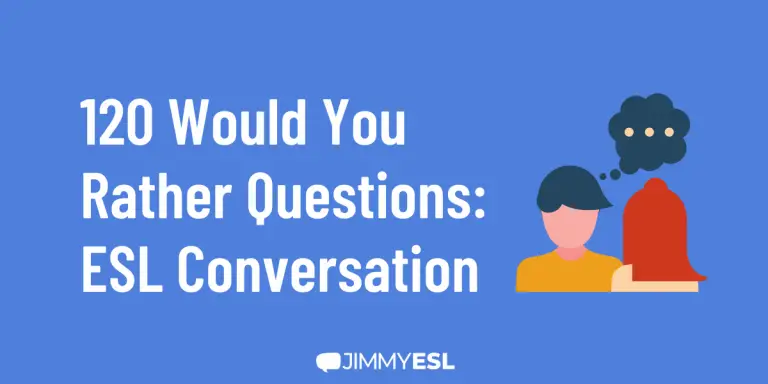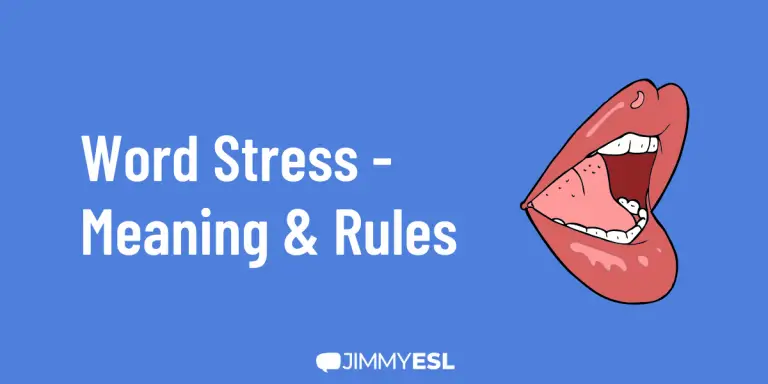How to Make a Lesson Plan for Teaching English (The Definitive Guide)
How can you build effective lessons and feel in control of the class?
Lesson plans are essential to planning and ultimately giving great ESL lessons.
But isn’t making lesson plans long and arduous? Well… not if you do things the right way!
In this article, you will learn to make a lesson plan for teaching English from scratch that is both effective and won’t eat up all of your time and energy!
Can You Teach Without a Lesson Plan?
The short answer is yes, you can teach a lesson without a plan. However…
You shouldn’t!
With one-to-one students, you usually have more freedom. If things don’t go quite right you can usually just keep talking and keep the flow going while working out what to do next.
In fact, I have a few students who just want to practise their free conversation and I just turn up and talk for an hour without anything planned.
However, for the majority of students (especially groups), not planning a lesson is not an option.
You need a clear idea of what you want your students to learn and how you are going to help them achieve that goal. The only way to do this is with a lesson plan.
Remember that you may think you’re saving time by not planning anything (or planning minimally) but you’ll regret it when you are in the middle of a stressful, unplanned lesson.
As Benjamin Franklin once said,
“By failing to prepare, you are preparing to fail.”
How to Create a Lesson Plan From Scratch
Does it matter which tool you use to create your lesson plan?
Not really, no.
The important thing is that you can easily and quickly create your plan, make adjustments (if necessary) and bring it to class with you.
You could…
Use Pen & Paper
This is the low-tech option but still popular, especially if you can’t get access to a computer.
You also have the advantage that you don’t have to worry about making a printout or bringing a laptop with you to class etc.
Use Word Processing Software
You can use Microsoft Word or any other popular application you would use for writing anything else.
Simply type it up and then either print a copy at the end or find some way of bringing it to class (laptop, mobile phone, classroom computer, etc.)
Use an Online Storage System
I started using Google Drive for my lesson plans a few years ago and haven’t gone back since!
The documents app has everything I need to type up my lessons and I know that everything is stored online which makes it easy to access.
Think About Presentation
Bear in mind that you should think about who will be looking at your plan. If you are working in a school or with an assistant then it is likely that others will see it.
Make sure it is neat enough that others can understand it and maybe spend some time on the presentation and making it look pretty.
However, if you are a freelance teacher then presentation doesn’t matter so much. As long you can make out what’s written and can follow it easily, you can have it look however you want!
Once you have decided on your tool to make your lesson plan, you then need to focus on what you actually will include in your plan.
Essential Parts to Include in an ESL Lesson Plan
Once you have the right tool for the job it’s important to focus on what you will include in your lesson plan. Some of these can be optional but pay attention to the essentials that will be marked.
In theory, you can do these in any order you want. However, going through in the order provided here will make your life a lot easier.
Parts of a Lesson Plan
- Date and time
- Class and Student Name, Number of Students
- Lesson Aims
- Lesson Duration
- Lesson Activities
- Bonus Activities
- Resources Needed
Here’s how a simple lesson plan template could look like:

Date and Time
It may seem trivial but you want to make sure you have the right lesson plan for the right lesson.
Get into the habit of including date and time to avoid confusion and turning up to class with the wrong plan!
This is also useful when the lesson plan needs to be filed after class (e.g. in a school).
Class and Student Name
Again, it comes down to making sure you are matching the right plan to the right class. This also helps you visualise your learners as you are making your lesson plan.
Number of Students
This one isn’t important if you just teach one-to-one lessons (obviously). However, if you are teaching group classes then the number of students in your class will need to be taken into consideration when planning activities.
Lesson Aims (Essential)
Ask yourself:
“What do I want my students to do at the end of this class that they couldn’t do before?”
This is your lesson aim and is one of the most important considerations when designing a lesson plan.
This can be seen as “What is the point of this class?”.
For vocabulary lessons, the lesson aim may be a list of words or maybe a certain concept if teaching a grammar lesson.
Whatever the reason is, make a note of it and always keep it in mind when you make any other decisions about the lesson plan.
Lesson Duration (Essential)
How long do you have to do the lesson?
In order to effectively plan your activities in class, you need to know how much time you have to work with.
Lesson Activities (Essential)
Create a list of every activity you plan to do in class. This needs to be precise and include things such as warm up, free conversation, explaining homework at the end, etc.
State how long each activity will take in minutes.
Obviously it is unlikely you will be able to stick to this exactly, things change and you need to go with the flow. However, try to stick as closely as you can to it and you will find your life will be much easier.
It doesn’t need to be said but, this needs to be done after your lesson aims, as they will dictate what activities will be appropriate for that class.
Bonus Activities
As well as planning your lesson activities, it’s a good idea to include some bonus activities that can be done in case you finish the class early.
You don’t want to run out of planned activities halfway through a class and have to improvise a class to a room of 30 students!
Get a couple of backup activities planned and take them to each class. A small amount of planning now will give you peace of mind in the long run.
Resources Needed (Essential)
Make a list of everything you need and pay attention to the details.
As well as noting down that you need printouts for that crossword, did you think about whether the students have pens or will you need to bring them? Do you have backups of lesson materials? A backup USB drive of the presentation etc?
Be prepared with all of this because there’s nothing worse than having to run out of class 5 minutes in because you forgot something small!
How to Structure an ESL Lesson
Ok so we know all of the details needed for the lesson plan but… how do we actually structure the activities in the class?
This is very much dependent on the type of class you are teaching and your style. As I’m teaching mostly one-to-one advanced students and my students require different things, my lesson plans vary quite a bit.
However, for “traditional” classes (groups from beginner to intermediate level) you will likely want to follow the classic PPP model which is mentioned extensively in TEFL courses.
What is PPP?
PPP is an acronym for presentation, practice, and production.
It is a popular model for teaching foreign languages and is one of the most popular teaching models used in TEFL courses.
Let’s look at each section in more detail with 5 great ideas for each!
Presentation
In our first section, presentation, we show the students something. It could be:
Ideas for Presentation
- A short, fictional story
- A video
- An object (a piece of fruit, a toy, etc.)
- A roleplayed conversation between the teacher and the assistant
- A news story
It could be anything, as long as it can stimulate a discussion about what you want to teach in the class.
For example, if I want to teach the past simple tense vs the past continuous, then I could find a story that uses both of these and highlight them.
Practice
In the next section practice, we give students a chance to use the new concept in a controlled environment. We could use:
Ideas for Practice
- Gap-fill exercises (a sentence with a word missing that a student has to fill)
- Sentence correction (students find the mistakes in an incorrect sentence)
- Sentence rearrange (students have to put the jumbled words of a sentence in the right order)
- Synonym matching (students have to match a word with its synonym)
- Word select (again, there’s a gap in a sentence but there are a selection of words to choose from)
The idea is that students can play with the new concept but they still have the “training wheels” on.
Production
The final stage, production, is much freer and allows the student to use the new concept with less help. Think of exercises like:
Ideas for Production
- Writing an essay (set an essay question; can be very good for homework assignments, too)
- Free conversation (split students into pairs and have them talk freely while incorporating the new concept)
- Asking questions (either ask the students yourself or split them into groups)
- Roleplays (split students into pairs and give them roles to act out)
- Information exchange (split students into pairs and have them find out certain information from the other)
This section is usually the most challenging as the students have much less support compared to the practice stage. However, it is essential for preparing students to use these new concepts in the real world.
Useful Tips for Lesson Planning
It’s Better to Overplan
When you are first starting out it is much better to over-plan everything.
Where will the students be sat? How long will it take to hand out the exercise sheets? Will you allow time for questions?
Start by overplanning and as you get more comfortable teaching, you can start taking out things that you don’t feel you need.
Don’t Reinvent the Wheel
There are plenty of pre-existing lesson plans out there just begging for you to use.
If your school or establishment has its own then you can use those and adapt them.
Have a look online for any free or paid downloadable lesson plans and even share them with other teachers.
You can keep these lesson plans as but you will likely want to tweak them to fit your class.
The point is, why struggle when the work is already done for you?
Browse our section of ESL teacher resources for lesson plans, worksheets, and other printables.
Include Lots of Student Activities
Make sure to include plenty of activities that get the students involved.
It’s difficult to write a lesson where you are talking for an hour straight and still managing to keep your students hooked and learning well.
When you include more student activities you find it’s easier to write the lesson, reduces teacher talk time and your students are more likely to learn effectively.
Make a Template
Once you have a lesson plan design that works, you can then use that as a template for the next lesson plan.
This can be a big timesaver as you don’t have to make everything from scratch each time.
Make Backups
Make sure you have a backup in case you lose your main plan. I used to keep digital copies of my lesson plans on my mobile phone so that I could check that in case anything happened.
Also, make sure your assistants have their own copy of the plan so they know what should be happening at each step in the class.
Practise the Activities
It’s especially important to practise the activities if it’s the first time doing them. As well as being able to perform the task properly in class, it allows you to see how long it will take.
This timing is important when planning your lessons as it allows you to be more precise with organising the timing of the activities and have a smoother flowing lesson.
Don’t Skip the Warmup
Whether you are teaching one-to-one or a room full of students, you shouldn’t skip the warmup. This is a chance to prepare the students for the lesson and flow naturally into the topic of the day.
Make sure to factor this into your plan. For larger classes, you may way to keep things a little more controlled and spend one or two minutes on the warmup.
For one-to-one classes, I usually aim for around 5-10 minutes as it allows me to personalise things a little more and build rapport.
The important thing though is this needs to be built into the timing of the lesson plan!
Need ideas? Read our posts on warm-up activities and icebreaker activities.
Make Room for a Review Section
I have found it to be vital to include review sections in class.
A lot of language learning is a memory game, this means that not only does a student have to learn a definition of a word or grammar concept but they have to remember it too.
If your student doesn’t revise then these things will escape the memory frighteningly quickly.
For this reason, I always build in a review section nearer the start of the lesson to check their knowledge of what we did in the previous lesson.
You can check pronunciation and definition of words or even a “Can you remember what we did in the last lesson?”.
As long as you are getting the students’ brains to reactivate some memories from what has been done before then they are more likely to remember these things in the long run.
Example Lesson Plan
Now we’ve covered everything that you need to create effective lesson plans.
Let’s look at an example lesson plan about IELTS Speaking Practise to give you an impression of how (simple) a lesson plan can look like!

Conclusion
There we have it, everything you need to start building your very own lesson plans from scratch.
Remember to experiment with the different parts you need for a lesson plan.
Once you have something that works, use that as a template for future lesson plans to make your life even easier!







Thank you so much 😊, I really needed some guidance! Thank you for sharing 😊
Thank you so much Jonathan for this wonderful piece. I have been inspired to effectively prepare my lessons. Good job!
Dear Jonathan,
I will be teaching first time on line and the information is very helpful to start.